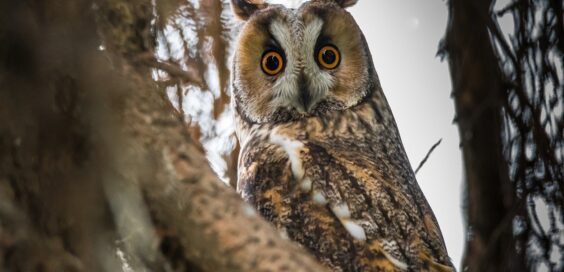
Creature Feature – My, What Big Ears You Have
Posted by Dustin Horton // September 13, 2021 // Articles, Creature Feature
The long-eared owl inhabits dense woodlands where its monotonous, low-pitched “hoot” can be heard almost one mile away. It’s a slender, medium-sized owl with elongated buff colored facial discs and orange eyes. Its body is splashed and streaked with black, brown, buff and white feathers. The two tall, prominent ear tufts that inspired its name, however, are certainly this owl’s most defining feature.
Between its nocturnal habits and superb camouflage, the long-eared owl can be difficult to spot; but in winter, large numbers can sometimes be seen roosting together in sheltered stands of trees.
The long-eared owl is a skilled flyer, silently hunting rodents and other small mammals in open, grassy places within or near the forest. It has extremely sensitive hearing enabling it to capture prey in total darkness.
This species often commandeers the nests of crows and other birds as well as squirrels, driving them off. Its eggs are incubated for approximately 1 month before hatching; then, about 5 weeks later, the juvenile owls are ready to leave the nest.
The oldest known long-eared owl was over 12 years old. First banded in New York, it was later discovered in Ontario, Canada.
Article by Margie Manthey
Photo from Pixabay













